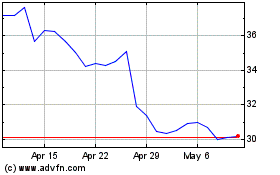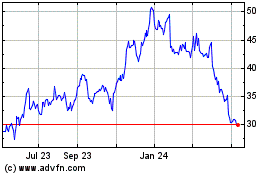Intel's Earnings Expected to Retreat as CEO Gelsinger Works Toward Revival
April 22 2021 - 9:29AM
Dow Jones News
By Paul Ziobro
Intel Corp. is expected to post lower quarterly sales and profit
as new Chief Executive Pat Gelsinger fast-tracks efforts to
re-energize the U.S. semiconductor giant against the backdrop of a
global chip shortage.
Mr. Gelsinger this month laid out an ambitious strategy for
Intel to become a major contract chip maker in addition to making
semiconductors to satisfy its in-house requirements. The plan
includes a $20 billion spending commitment to build two new
semiconductor plants in Arizona.
The CEO, on the job since February, also pledged to make some
production capacity available swiftly to help alleviate a broader
shortage of chips that has caused disruptions across a range of
industries, in particular car production.
The White House this month met with executives from the chip and
other industries to help determine what action it should take to
address the shortage and strengthen the domestic chip-building
industry. President Biden previously pledged to fix the chip
shortages and included $50 billion for the semiconductor industry
in his expansive infrastructure-spending package.
Intel on Thursday is due to post its first quarterly earnings
with Mr. Gelsinger at the helm. Wall Street on average expects the
company to report a roughly 10% decline in first-quarter sales to
$17.8 billion and net income of $4.3 billion, according to analysts
surveyed by FactSet. Intel has said it expected to generate revenue
of about $17.5 billion, stripping out revenue from the memory
business it plans to sell to South Korea's SK Hynix Inc.
The projected sales drop comes despite strong demand for chips
broadly. Vivek Arya, a semiconductor analyst at Bank of America,
said that Intel is being held back by several factors. Among those
are that a surge in demand for personal computers is centered
largely on lower-end devices like Chromebooks, while Apple Inc. is
ditching Intel for in-house chip designs on some of its equipment.
And after a strong year of spending on data centers, outlays this
year are expected to advance at a slower pace, he said.
Mr. Arya expects Intel's sales growth to trail that of the
broader sector, which he projects will increase around 15% this
year.
Mr. Gelsinger is trying to rebuild a company that has suffered
repeated setbacks in making its most advanced chip and that has
lost ground to Asian rivals. Mr. Gelsinger last month said the
company was making progress on its newest chips, though analysts
have said they want more detail.
Intel also has said it would increase outsourcing of some chip
production to keep pace, he said.
The company also is contending with increased competition.
Nvidia Corp. -- which last year overtook Intel as American's most
valuable chip company -- and Advanced Micro Devices Inc. have taken
market share. Nvidia this month also said it would start selling
central-processing units for data-centers, a market Intel has long
dominated. Intel this month introduced an enhanced data-center
chip.
Intel's effort to become a contract chip maker also isn't
without hurdles. The company has tried to break into that market
before, with little success. And its chief rivals, Taiwan
Semiconductor Manufacturing Co. and Samsung Electronic Co., are
readying their own multibillion-dollar spending plans to expand.
TSMC last week raised its capital-expenditure plan for this year to
$30 billion while lifting its sales forecast. Samsung has earmarked
$116 billion in investment by 2030 to diversify chip
production.
Mr. Gelsinger has said Intel is planning additional chip
investments. The company could benefit from the bipartisan support
in Washington for U.S. chip companies. For instance, Intel is
bidding on a Pentagon contract to help fund domestic chip-making to
meet government security needs.
Intel last month said it expects revenue this year to decline
from $77.9 billion in 2020 to $72 billion, reflecting the memory
business being sold. The company has forecast $19 billion to $20
billion in capital spending for the year.
Write to Paul Ziobro at Paul.Ziobro@wsj.com
(END) Dow Jones Newswires
April 22, 2021 09:14 ET (13:14 GMT)
Copyright (c) 2021 Dow Jones & Company, Inc.
Intel (NASDAQ:INTC)
Historical Stock Chart
From Mar 2024 to Apr 2024

Intel (NASDAQ:INTC)
Historical Stock Chart
From Apr 2023 to Apr 2024
